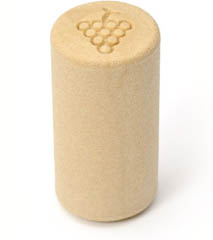 More and more often, when you go to decant a bottle of commercially made wine, it’s going to be a synthetic cork that pops out. The numbers are hard to pin down, but best estimates guess that roughly 9% of all commercially corked bottles of wine in the world today are corked with synthetic corks, and these numbers appear to be on the rise.
More and more often, when you go to decant a bottle of commercially made wine, it’s going to be a synthetic cork that pops out. The numbers are hard to pin down, but best estimates guess that roughly 9% of all commercially corked bottles of wine in the world today are corked with synthetic corks, and these numbers appear to be on the rise.
Global wine sales have been on the rise as well. For several decades the wine market has seen an increased demand for its product. So much so, that the supply of natural cork has not been able to keep up. Every year more and more wine is being bottled, and every year more and more cork bottle stoppers are needed to close them.
The primary reason that the supply of cork has gotten behind the demand is because it is a natural product. It’s actually the bark of the ‘cork oak’ tree. Every so many years this freakishly thick looking bark is stripped from the trees and then processed into the shape of a cork bottle stoppers. Eventually, the bark grows back on the trees, and the process is repeated all over again—a cycle that takes about 7 years.
This process of ‘strip the bark and repeat’ is all well and good for the current demand, but when you have new demand on top of that, you have to plant more cork trees. This is where the cork market has gotten itself out of balance.
It takes on average 25 years for a cork tree to grow and to mature into an actual cork producer. This is a length of time that would be considered to be way out on the horizon in any industry.
So in effect, the cork producers are being asked to predict the future further than a generation down the road. By putting yourself in their shoes, you can begin to imagine how difficult it would be to know when and how many trees to plant. This is the equation that has allowed the cork stopper producers to be caught flat-footed.
This is part 1 of a 4 part series. In the next post (part2), we will cover how this lack of supply spawned the emergence of synthetic corks.
———————————————————————————————————
Ed Kraus is a 3rd generation home brewer/winemaker and has been an owner of E. C. Kraus since 1999. He has been helping individuals make better wine and beer for over 25 years.
Category Archives: Wine
Home-Made Wine Making Experience
A friend had given me a wine-making recipe that I have used for several years. It doesn’t call for special yeast’s, but one regular pack of bread yeast. One quart of Cranberry Juice; two cans of Concentrated Grape Juice; One pound of white cane sugar. Plus one gallon glass jug, rubber cork & economy-lock.
I dissolved the yeast first, place in the jug first. Then I semi-dissolve the sugar in the juices, and place that in the jug. Fill the rest of the jug with water to an inch below the neck of the jug. The rubber cork with a hole thru it, place in the top of the jug. Fill the economy-lock half-full of water and place it in the hole of the cork.
It takes one month to brew.
During that time of brewing, I go to the bars in town, asking the bartenders for any empties of whiskey or wine bottles (especially the dark brown and green bottles). Never the clear glass bottles!! Those clear bottles turn my grape wine brown in color and taste like raisin wine.
I clean out the bottles by using the hottest water to sterile the bottles. It also makes it easy to clean the labels off the bottles.
( Of the bottles that I collect from the bars, I try to make sure that each bottle has it’s screw-on cap.)
Try these suggestions:
Change the Concentrate Grape Juice for White Apple Juice, and change the Cranberry Juice for White Grape Juice.
OR
Change the cranberry juice to raspberry juice and grape juice to cherry juice.
Jerry
Name: Jerry Schachterle
State: Michigan
It's Day 8. Shouldn't My Wine Be Fermenting?
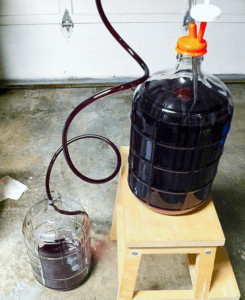 Hi:
Hi:
Today is day 8 and I just transferred my wine from the plastic fermenter to a glass carboy like the homemade wine instructions say to do. I do not see the wine brewing at all. Shouldn’t the wine still be fermenting? Do I have a problem?
Please help!
Robert
—–
Hello Robert.
I am going to assume that you are making your wine from a wine ingredient kit such as our European Select or KenRidge Classic since you mentioned “day 8” much like their directions would.
How fast your fermentation goes can vary. On average, the fermentation should almost be done, if not done completely, by day 8. But sometimes a fermentation will go faster or slower than the wine making directions anticipated. This is normally due to the environmental conditions of the fermentation, such as: the temperature of the wine must, the nutrients in the water you used, etc.
Regardless of how fast your wine must is fermenting, the important thing to know at this point is that it is either still fermenting, or it has completed the fermentation. Luckily for you this can be easily be determined by taking a reading with a wine hydrometer. Hopefully you have one. If you do not, order one today.
A wine hydrometer is very easy to uses. It’s a glass tube with a weight at one end. You simply put it into your wine must and see how high or low it floats. It has no moving parts. Nothing goes up and down inside of the wine hydrometer like a thermometer does. It just floats. Wherever the surface of the wine crosses the scale on the wine hydrometer, that’s your reading. This is why sometimes it is referred to as a gravity hydrometer.
If the wine hydrometer reads .998 or less on the S.G. scale (Specific Gravity), this means that your wine is no longer fermenting because it is done with the fermentation. If the reading is above the .998 this means that the fermentation still has a little more work to do.
If you are seeing absolutely no activity with a wine hydrometer reading above .998, it would be much to your advantage to go over the Top 10 Reasons For Fermentation Failure. This article will provide you with wine making tips that will help you get your fermentation back on track.
If the fermentation is done, continue on with the homemade wine instructions you have. Do not speed up the timetable of the directions. Follow the original schedule.
Happy Wine Making,
Customer Service at E. C. Kraus
———————————————————————————————————
Ed Kraus is a 3rd generation home brewer/winemaker and has been an owner of E. C. Kraus since 1999. He has been helping individuals make better wine and beer for over 25 years.
Is The Carboy Half Empty Or Half Ruined?
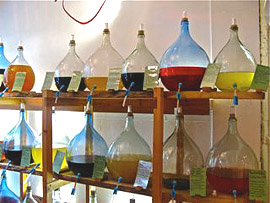 Hi E.C.Kraus!
Hi E.C.Kraus!
I’m new to home winemaking. I made red and white wines this year and have them resting in 54 L carboys (with air-locks) after the initial fermentation is completed. The storage room does have a pretty high temperature (65degF), but it doesn’t fluctuate.
After a month, I decided to start drinking the red one. It tastes great now. So, every weekend I open the carboy and have 1.5 L of wine siphoned into a regular bottle.
I’m wondering if opening the carboy every week (as a result more air in the carboy) can quickly harm/destroy the rest of the wine or not? Unfortunately, I couldn’t find the proper answer anywhere. I hope you, as a Guru in home wine making, could possibly advise me on this matter.
Thanks in advance for your appropriate reply.
Michael
—–
Dear Michael,
Sorry to say, but what you are doing is just not going to work.
Your concerns are well placed. Having more air, or an increasing head-space, in any type of carboy will eventually be a bad thing for wine. In the short term–a few days or so–you’re probably okay, but over time the air will have its way with the wine.
The first thing that happens when you drain the wine from the carboy is it increases the surface contact area between the air and the wine. When the carboy is full and the wine is up into the neck, you may only have 3 square inches of contact space. When the carboy isn’t full you could have over a square foot of contact area–144 square inches or more.
What this all means for the wine is oxygen now has the ability to saturate into the wine at a much faster rate than before. Eventually the wine will begin to show signs of oxidation. The wine’s color will start turning brown, and the flavor and aroma will start to take on carmel characteristics.
The second thing having a half-full carboy can do to the wine is spoil it. Mold, bacteria and other little nasties are floating around in the air. They are everywhere. An individual cell or spore is no threat, but if it is in some of the air that is brought into the head space, it will have a place to land with plenty of nutrients available with which to grow.
Understand, that oxidation and spoilage will not happen overnight. But day by day, week by week it will slowly progress.
Having said all of this, the solution is simple. Be sure you are using sulfites on the wine such as sodium metabisulfite, and either bottle your wine or keep your carboys full. Even bottling the wine in gallon glass carboys or gallon glass jugs would be a vast improvement over your current situation.
Happy Wine Making,
Customer Service
———————————————————————————————————
Ed Kraus is a 3rd generation home brewer/winemaker and has been an owner of E. C. Kraus since 1999. He has been helping individuals make better wine and beer for over 25 years.
How Do I Get Sulfites In My Wine Like The Wines At The Store?
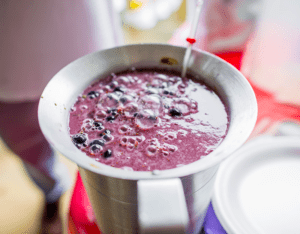 Hi:
Hi:
I made 5 gallons of Sauvignon Blanc this past year. I will be ready to bottle in the near future. I read on most commercial wine bottles that they contain sulfites. My understanding this is a stabilizer and to protect the wine yeast from refermentation. I am in the process of sending an order in and would like to know what to use and what amt. per gallon?
Thanks TOM
—–
Hello Tom,
Sulfites are added to a wine just before bottling, primarily to help eliminate spoilage and keep the wine’s color from turning through a process of oxidation. It does this by killing any traces of wild mold or bacteria that may have found its way to the wine and by driving the oxygen out of the wine.
Sulfites are not affective in squashing a refermentation, particularly if you have added an actual wine yeast to the wine as opposed to relying on wild yeast from the grapes to do the job. Domesticated wine yeast is somewhat resilient to sulfites, while wild yeast can be easily destroyed by it.
If you are concerned with the possibility of a refermentation occurring, you will also want to add potassium sorbate in addition to the sulfites, however this should only be necessary if the wine yeast did not completely ferment all the sugars in the wine must, or if sugar has been added back to the wine before bottling as a means of sweetening it.
The easiest way to add sulfites to your wine is to use sodium metabisulfite. We offer it as a granulated powder. You simply dissolve it into the wine right before you bottle. Make sure that the sodium metabisulfite gets evenly disbursed throughout the entire batch. A good way to go about this is to add the sodium metabisulfite to quart or so of the wine first, to dissolve it. Then blend the mixture into the rest of the batch.
The dosage of sodium metabisulfite you need is very small. You use 1/16 of a teaspoon for each gallon of wine. If you don’t have a 1/16 teaspoon, then use 1/8 teaspoon for each 2 gallons of wine. This is the same way wineries go about getting sulfites in the wine.
Happy Wine Making,
Customer Service at E. C. Kraus
———————————————————————————————————
Ed Kraus is a 3rd generation home brewer/winemaker and has been an owner of E. C. Kraus since 1999. He has been helping individuals make better wine and beer for over 25 years.
My Wine's About Done, But Tastes Terrible!
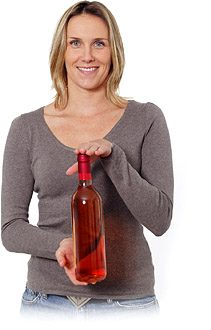 Dear Kraus:
Dear Kraus:
I am new at this wine making process. I am in the last stages and decided to take a small taste test even though I still have 2 or 3 days left in the last stage. It is terrible! Can the wine get better in that short period of time or is it to far gone and will not come out good?
Please Help, Gwen
—–
Hello Gwen,
It is completely normal for a wine to be harsh at bottling time. Even though the wine is about to go into bottles it does not mean that it is done becoming wine.
The wine will continue to evolve through aging or maturation. This simply means it will slowly change over time–in a good way– while it is in the wine bottle. Organic changes will slowly occur over the course of the next few months that will round off the harsh corners of the wine.
You can think of wine as a living thing. Even though it is done fermenting, clearing and in the bottle, it is still going through changes. Each wine ages differently. So how long your wine will take to become its best can only be a guess, but it is safe to say that after aging for 3-6 months you will notice a remarkable improvement. You may notice even marginal improvements up to 3 years, depending on the type of wine.
Best Wishes,
Customer Service at Adventures in Homebrewing
———————————————————————————————————
Ed Kraus is a 3rd generation home brewer/winemaker and has been an owner of E. C. Kraus since 1999. He has been helping individuals make better wine and beer for over 25 years.
What's Happening To My Wine?
 Hi,
Hi,
I crushed my grapes in late September & squeezed them. Then racked it 2 times since then. It’s been almost 2 months since the last racking and 1 of the 5 gallon wine carboys is starting to bubble again just slightly. What is happening should I do anything. The other 3 carboys are not doing this???
Thanks Rick
—–
Hello Rick,
It’s hard to know exactly what is going on with your forth carboy, but here are your possibilities:
1) Your wine has started to ferment again: This means that the original fermentation did not consume all the original sugars before it stopped. This is known as a stuck fermentation. You can verify this, or rule it out, by taking a reading with a gravity hydrometer.
If the reading on the specific gravity scale reads .998 or higher, then there are still some sugars to be fermented. Your best course of action would be to make sure the wine carboys are not too cold, at least 70F., and wait until all the sugars are fermented.
2) You added more sugar after the fermentation: If you added more sugar to sweeten the wine after the fermentation completed but did not add a wine stabilizer along with the sugar, you are in the same situation as before. The wine has started to ferment again. The only thing that you can really do at this point is to let the wine finish out the fermentation with the newly added sugars.
If you want a sweet wine, add sugar again, after the fermentation. Only this time also add Potassium Sorbate along with the sugar. This will inhibit the fermentation from restarting.
3) Your wine has become infected with a bacteria: This may be the case if you take a reading with a gravity hydrometer and it does not indicate that there are any sugars left in the wine carboy. This does not necessarily mean it is ruined, but it needs to be addressed.
Bacterial infection is something that normally happens when sulfites such as Campden Tablets or Potassium Metabisulfite are not used after the fermentation. In any event, the problem is easily rectified by adding a dose of either of these to destroy the bacteria.
Hope this helps you out.
Happy Wine Making,
Customer Service
———————————————————————————————————
Ed Kraus is a 3rd generation home brewer/winemaker and has been an owner of E. C. Kraus since 1999. He has been helping individuals make better wine and beer for over 25 years.
What's The Solution For The Bottle Tree Rinser?
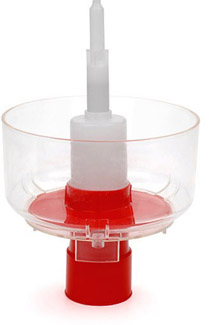 Kraus folks:
Kraus folks:
Could you tell me what solution should go into the bottle tree rinser — could I use campden tables?
Rick F.
—–
Hello Rick,
The Bottle Tree Rinser/Sulphatizer is designed to be used with a sulfite solution. What this means is that you can use either Campden Tablets, Sodium Metabisulfite or Potassium Metabisulfite with water to make the sanitizing solution that goes into the bottle rinser’s reservoir.
The dosage is pretty straight-forward. You use either 16 Campden Tablets or one teaspoon of either Potassium or Sodium Metabisulfite per gallon of water. Go ahead an mix up a gallon of it in a gallon glass carboy or similar. You’ll need to refill the reservoir as the process goes on.
The bottle rinser works by spraying the solution up into the wine bottles. You put the wine bottle over the nozzle and pump it up or down to cause a spray into the bottle. You then put the wine bottle on one of the bottle tree pegs to drain.
This spray action does two things: it rinses the wine bottle out, getting rid of box dust and the like; it also causes the sulfites in the water solution to release as a gas within the wine bottle. This sulfite gas lingers within the wine bottle, sanitizing it over the course of the next few minutes.
Ideally, the sulfite gas from the sodium metabisulfite, etc. would still be in the wine bottle as it is being filled with wine. This would keep contamination down to an absolute minimum. With this in mind, one of my wine making tips is that the wine bottles be filled and corked within a half-hour or so of being sprayed.
Happy Wine Making,
Customer Service
———————————————————————————————————
Ed Kraus is a 3rd generation home brewer/winemaker and has been an owner of E. C. Kraus since 1999. He has been helping individuals make better wine and beer for over 25 years.
Sweeten Your Homemade Wine With Stevia
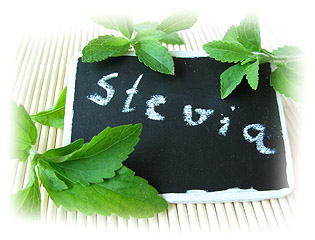 Dear Kraus,
Dear Kraus,
Has anyone used STEVIA to sweeten the wine before bottling? It might take more than expected but I would like to try it.
I am Diabetic and adding sugar to sweeten the wine just adds problems, so I don’t drink my wine, which my wife is okay with… because she can drink it without problem.
Could there be problem using this sweetener after fermentation?
Thanks in advance.
Bob W.
—–
Hello Bob,
There is nothing wrong with using stevia to sweeten a wine at bottling time. I have not used it myself, but I know that there are individuals out there who have been using it for this purpose.
I would go at it cautiously to see if you like how it tastes in the wine before committing an entire batch to the stevia. Maybe take some of the wine off into a gallon glass carboy. Then add measured amounts of stevia to it until it becomes the sweetness you like.
This will save you from accidentally ruining the whole batch of wine with the stevia. It will also help you to establish a dosage of stevia for the rest of the wine. That way there’s no risk of adding too much. There are no wine making books or solid information on the internet that really covers this subject, so you have to take it a step at a time.
Stevia is supposed to be non-fermentable. I would be cautious of this fact as well. I would not be surprised if stevia does not start to ferment slightly over time. For this reason I would also recommend using Potassium Sorbate along with the stevia to make completely sure the wine does not ferment somewhere down the road. And as always, also use sodium metabisulfite before bottling the wine.
Happy Wine Making
Customer Service
———————————————————————————————————
Ed Kraus is a 3rd generation home brewer/winemaker and has been an owner of E. C. Kraus since 1999. He has been helping individuals make better wine and beer for over 25 years.
Homemade Grape Crusher
I discovered this grape crusher on line two years ago and fabricated my own version. I can crush 5 gallons of grapes in 2-3 minutes using my drill. Check out the last image which is a video of Steve’s unit.
I left off the de-stemming tray and just set the crusher right on a 6 gallon plastic bucket.
I encourage all with a few simple woodworking skills to study the photos and make their own. Very inexpensive and superior to any manual (i.e. foot crushing) process.
Name: Phillip Deal
State: South Carolina
